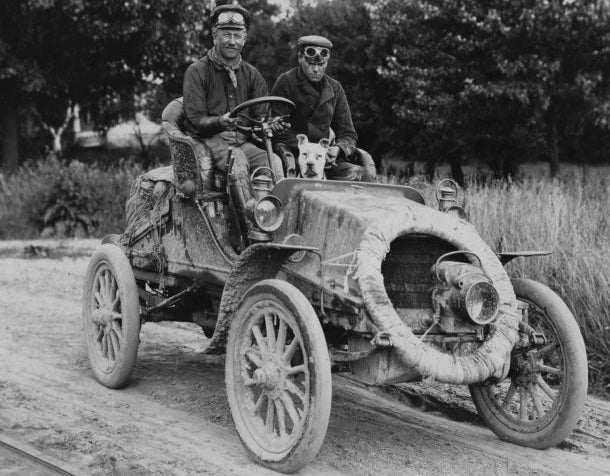Overlanding as we know it today started off with a wager. On May 18, 1903 at the University Club in San Francisco, former doctor Horatio Nelson Jackson, while on a visit from Vermont, took a $50 bet that he couldn't drive an automobile cross-country to New York. Notwithstanding the fact that no such voyage had ever been successfully completed, the perhaps overly confident Jackson — lacking any practical mechanical knowledge — enlisted mechanic Sewall K. Crocker to come along for the ride. Hastily purchasing a well-worn, two-cylinder 20 horsepower Winton and assembling a bare-bones set of supplies that included sleeping bags, pistols, and whatever spare parts they could get their hands on, Jackson and Crocker headed eastward.
Over the next 63 days, Jackson and Crocker — joined later by Bud, a pitbull picked up along the way — encountered a string of navigational mishaps and near-constant mechanical failures, eating and sleeping alongside rudimentary dirt roads. Yet after a punishing 5,600 miles, the little Winton managed to limp into New York, with Jackson and Crocker successfully completing the historic voyage while becoming, in the process, the country’s first automobile-age overlanders. Memorialized decades later in Ken Burns’s 2003 documentary Horatio's Drive: America's First Road Trip, Jackson and Crocker’s journey ignited America’s decades-long infatuation with long-distance motor-driven exploration that continues to this day.
While travelers have crossed vast distances on foot, horseback, or wheeled vehicles for millennia, the fundamentals of land travel were relatively little changed until the internal combustion engine. But change came quickly in the 20th century, creating what we now know as recreational road travel.
Just seven years after Jackson and Crocker’s coast-to-coast drive, Pierce Arrow debuted the Touring Landau, a rudimentary overlanding rig featuring a rear seat that converted to a bed, a fold-down sink, and a chamber pot. In 1918, aircraft designer Glenn Hammond Curtiss introduced the first solidbody trailer coach. By 1923 the Zagelmeyer Auto Camp Company offered kits to convert a Ford Model T into a pop-top camper with fold-down side beds. Meanwhile, the United States began to place a greater emphasis on nurturing its natural resources after President Woodrow Wilson created the National Park Service by signing the Organic Act of 1916.
 A Zagelmeyer Auto Camp Company Model T conversion, circa 1920s.
A Zagelmeyer Auto Camp Company Model T conversion, circa 1920s.
By the mid-20th century, with private automobile ownership growing exponentially, tens of thousands hit the road for the first time every year, looking to discover the natural beauty of their own country. As Peter Schmitt wrote in 1967, the "back to nature" movement that saw affluent Americans bring nature to the city by way of urban parks and estate gardens in the late 19th and early 20th century "shifted from being a luxury of the rich to a preoccupation of an urban middle-class." For this growing middle class, “the recreational vehicle came to serve as a means of taking the urban lifestyle to nature's arena.”
Few today would be interested in a punishing two-month journey in a roofless car powered by an engine smaller than that of many modern riding lawnmowers. Damp sleeping bags and leaky improvised shelters have been replaced by weatherproof tents and many of the conveniences of home. Yet Jackson and Crocker’s journey more than a century ago set the tone of what overlanding is and what it will always be.
While precise definitions differ, overlanding is typified by the experience of packing up a vehicle — whether a small city coupe or tank-like 4x4 — and setting off with a vague idea of where to go, veering off the beaten path, and plugging into pure nature on one’s own terms.
 Hawkes Ford Raptor conversion with rooftop tent.
Hawkes Ford Raptor conversion with rooftop tent.
Aside from some type of motorized vehicle, overlanding does not require a specific set of gear. An overlander need not look a certain way, speak a particular language, or have a set amount of money in the bank. At its most orthodox, overlanding is often defined as an extended, perhaps weeks- or months-long activity that crosses state or even national borders — some purists would say only this kind of travel constitutes “real” overlanding. But today, overlanders include everyone from the city-dwelling enthusiast to serious off-gridders, customizing small hatchbacks, pickup trucks, or SUVs and setting off for weekends in the country or long treks over harsh terrain.
Anyone can be an overlander, and over the past two years, many have become overlanders for the first time. With millions kept indoors for extended periods due to the COVID-19 pandemic, the prospect of a getaway in one’s own vehicle and the freedom to explore, create new memories, and enjoy new experiences is increasingly irresistible. This is fostering breakneck transformation in the world of overlanding, bringing new faces and enticing innovative brands to enter the scene. The rush is on now to manufacture the lightest, thinnest rooftop tent, most efficient generators and batteries, best off-grid outdoor shower, or most portable stove to offer the conveniences of home virtually anywhere on earth.
Overlanding is what you make it. Rather than “what is overlanding?” perhaps a better way to frame the question is: “what is overlanding to you?”
See more by subscribing to our #newsletter here at Hawkes Outdoors!


0 comments